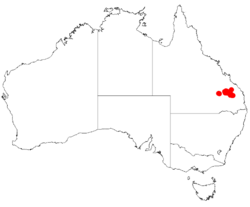Biology:Acacia calantha
| Acacia calantha | |
|---|---|
| Scientific classification | |
| Kingdom: | Plantae |
| Clade: | Tracheophytes |
| Clade: | Angiosperms |
| Clade: | Eudicots |
| Clade: | Rosids |
| Order: | Fabales |
| Family: | Fabaceae |
| Subfamily: | Caesalpinioideae |
| Clade: | Mimosoid clade |
| Genus: | Acacia |
| Species: | A. calantha
|
| Binomial name | |
| Acacia calantha Pedley
| |

| |
| Occurrence data from AVH | |
Acacia calantha is a shrub belonging to the genus Acacia and the subgenus Phyllodineae native to Queensland in Australia.
Description
The dense glabrous shrub typically grows to a height of 1 to 3 metres (3 to 10 ft).[1] It has slender, glabrous yellowish brown to grey branchlets with green to grey green phyllodes. The erect and filiform phyllodes have a length of 7 to 15 cm (2.8 to 5.9 in) and a width of around 1 mm (0.039 in). They have a prominent midrib which becomes angled with three or four distinct longitudinal ridges when dry. The simple inflorescences appear in the axil nodes as single spherical flower-heads containing around 30 bright golden flowers. The seed pods that form after flowering have a narrowly oblong shape and have a length of up to about 6 cm (2.4 in) and a width of 5 to 6 mm (0.20 to 0.24 in). The dark brown to black seeds within have an oblong to elliptic shape with a length of 3 to 4 mm (0.12 to 0.16 in).[2]
Taxonomy
The species was first formally described by the botanist Leslie Pedley in 1979 in the work A revision of Acacia Mill. in Queensland as published in the journal Austrobaileya. Pedley then reclassified the shrub in 1987 as Racosperma calanthum but it was transferred back to the current name in 2001.[3]
Distribution
The shrub is native to an area around Cracow in south eastern Queensland in the Dawson River catchment.[1] It is found on the lower slopes of steep sandstone hills and ridges growing in sandy to sandy-clay soils as a pat of dry sclerophyll forest communities as is often associated with species including Corymbia maculata, Corymbia trachyphloia, Eucalyptus crebra, Eucalyptus cloeziana, Eucalyptus citriodora, Corymbia tessellaris, Angophora leiocarpa, Lysicarpus angustifolius, Acacia podalyriifolia and Acacia crassa.[2]
See also
References
- ↑ 1.0 1.1 "Acacia calcarata". World Wide Wattle. Western Australian Herbarium. http://worldwidewattle.com/speciesgallery/calantha.php.
- ↑ 2.0 2.1 "Acacia calantha". WetlandInfo. Department of Environment and Science, Queensland. https://wetlandinfo.des.qld.gov.au/wetlands/ecology/components/species/?acacia-calantha.
- ↑ "Acacia calantha Pedley". Atlas of Living Australia. Global Biodiversity Information Facility. https://bie.ala.org.au/species/http://id.biodiversity.org.au/node/apni/2920995#names.
Wikidata ☰ Q15289421 entry
 |

